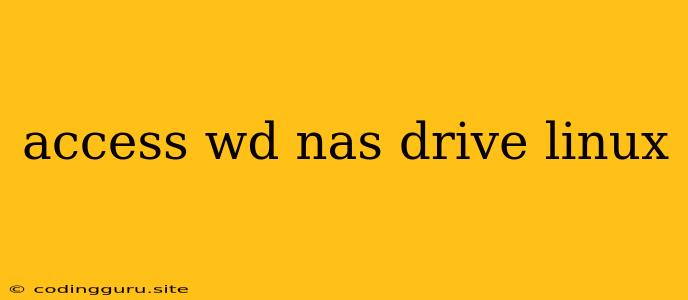Accessing Your WD NAS Drive from Linux: A Comprehensive Guide
Accessing your Western Digital (WD) Network Attached Storage (NAS) drive from a Linux system can be a straightforward process, but it often involves understanding a few key concepts and steps. This guide aims to provide you with the necessary information to successfully connect to your WD NAS drive from your Linux machine.
Understanding the Basics
Before we delve into the specifics of connecting your WD NAS drive to your Linux system, let's clarify some fundamental aspects:
1. Network Connectivity: Your WD NAS drive needs to be connected to your network. This typically involves connecting it to your router via an Ethernet cable.
2. IP Address: Every device on your network, including your NAS drive, has a unique IP address. You'll need to know your WD NAS drive's IP address to connect to it.
3. File Sharing Protocol: Your WD NAS drive needs to be configured to share files using a protocol that your Linux system can understand. Commonly used protocols include:
* **SMB/CIFS (Server Message Block/Common Internet File System):** A widely used protocol for file sharing on Windows and Linux systems.
* **NFS (Network File System):** A protocol designed for sharing files over a network in a UNIX-like environment.
Accessing your WD NAS Drive through the Web Interface
Most WD NAS drives come with a built-in web interface that allows you to manage various aspects of your device, including file sharing settings. You can access this interface through a web browser by entering your WD NAS drive's IP address in the address bar.
Steps to Access the Web Interface:
- Find your WD NAS drive's IP address: This information is typically found in your router's settings.
- Open a web browser on your Linux machine: You can use Firefox, Chrome, or any other preferred browser.
- Enter the IP address of your WD NAS drive in the browser's address bar: For example, you might enter
http://192.168.1.100. - Log in using your WD NAS drive's credentials: If you haven't already set them up, you'll need to create a user account and password.
Connecting via SMB/CIFS
Connecting to your WD NAS drive via SMB/CIFS is often the simplest method, especially if you're familiar with file sharing protocols.
Steps to Connect via SMB/CIFS:
-
Install the necessary software: Most Linux distributions have the
sambapackage pre-installed. If not, you can use your distribution's package manager to install it:- Ubuntu/Debian:
sudo apt-get install samba - Fedora/CentOS:
sudo dnf install samba - Arch Linux:
sudo pacman -S samba
- Ubuntu/Debian:
-
Open a file manager: You can use your desktop environment's built-in file manager (like Nautilus in GNOME or Dolphin in KDE) or a command-line utility like
nautilus. -
Connect to your WD NAS drive: Look for an option to connect to a network location or server. You'll typically need to enter the following information:
- Server: Your WD NAS drive's IP address (e.g.,
192.168.1.100). - Share name: The name of the shared folder on your WD NAS drive (e.g., "Public").
- Username and password: The credentials you set up on your WD NAS drive.
- Server: Your WD NAS drive's IP address (e.g.,
-
Mount the shared folder: Depending on your file manager and operating system, you may need to manually mount the shared folder.
Example (Using Nautilus):
nautilus smb://username:[email protected]/share_name
Replace username, password, 192.168.1.100, and share_name with your specific values.
Connecting via NFS
While SMB/CIFS is the most common protocol for file sharing between Windows and Linux systems, NFS is a more robust and efficient protocol designed specifically for UNIX-like environments.
Steps to Connect via NFS:
-
Enable NFS on your WD NAS drive: This is usually done through the web interface of your WD NAS drive. You'll need to locate and activate the NFS service or configure specific shares to be exported via NFS.
-
Install the necessary software: Most Linux distributions have the
nfs-commonpackage pre-installed. If not, install it:- Ubuntu/Debian:
sudo apt-get install nfs-common - Fedora/CentOS:
sudo dnf install nfs-common - Arch Linux:
sudo pacman -S nfs-common
- Ubuntu/Debian:
-
Mount the shared folder: You can mount the NFS share using the
mountcommand:-
sudo mount -t nfs 192.168.1.100:/export/path/to/share /mnt/wdnas -
Replace
192.168.1.100with your WD NAS drive's IP address,/export/path/to/sharewith the path to the exported share on your WD NAS drive, and/mnt/wdnaswith the desired mount point on your Linux system.
-
-
Automate the mount process: To automatically mount the shared folder upon system startup, you can add a line to your
/etc/fstabfile. The line should look something like this:-
192.168.1.100:/export/path/to/share /mnt/wdnas nfs defaults 0 0 -
Replace the placeholder values as described above.
-
Troubleshooting
If you're facing issues connecting to your WD NAS drive from Linux, here are some common problems and solutions:
- Incorrect IP address: Double-check that you're using the correct IP address for your WD NAS drive.
- Incorrect username/password: Ensure you're entering the correct credentials for your WD NAS drive account.
- Firewall blocking access: Make sure that your firewall is not blocking access to the WD NAS drive. You may need to create a rule to allow access.
- NFS server not running: Verify that the NFS server is running on your WD NAS drive.
- Incorrect share name: Check that the share name you're trying to access matches the name on your WD NAS drive.
Conclusion
Accessing your WD NAS drive from Linux can be a valuable way to manage and share files across your network. This guide has provided a comprehensive overview of the process, covering the essentials of network connectivity, file sharing protocols, and common troubleshooting steps. Remember to use the appropriate IP address, share names, and credentials for your specific setup. With the information provided in this guide, you'll be well on your way to seamlessly accessing your WD NAS drive from your Linux machine.
